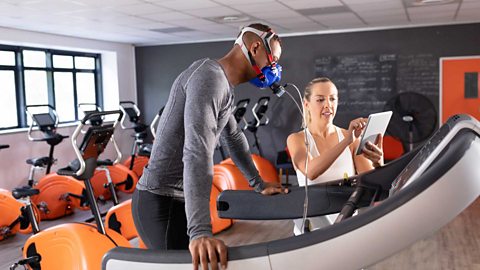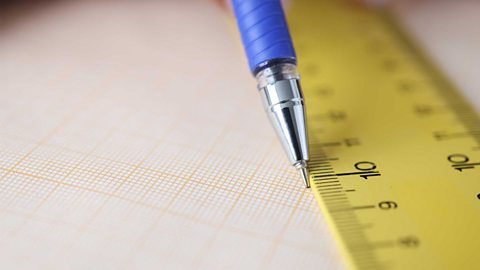Key points
- Calculating averageA number that shows a typical value in a set of data. Examples include mean, median and mode. from data is usually more accurate than using just one result.
- Choosing the correct range and intervals for recording data is important in order to reach valid conclusions.
- Recording data in a table ensures that data is recorded in an organised way.
What should you draw before an experiment to organise your results?
A results table.
Video
Watch this video about collecting data during an investigation.
While watching, look to see how to choose the right unit of measurement
Presenter 2: In this film, we will look at how to collect valid measurements when we carry out an experiment.
Presenter 1: For example, I want to investigate the distance a car travels when the height of the ramp is changed.
Presenter 2: When you are planning an investigation like this, it's important to complete a rough test first.
Presenter 1: Why?
Presenter 2: Because it lets you see the range, which is the spread of data from the lowest value to the highest value.
Presenter 1: OK, we don't have enough room here. We will need to move the car.
Presenter 2: Exactly. So, you'll be able to get an idea of the largest distance that the car will travel.
Presenter 1: And the smallest distance, which is zero here.
Presenter 2: We don't use a 30-centimetre ruler because the distance is much longer than 30cm. The appropriate instrument will be the 30-metre tape measure.
Presenter 1: But what exactly are we measuring? Do we go from the top of the ramp or the bottom? The front of the car or the back?
Presenter 2: The important thing is that you're consistent. If you measure, from the bottom of the ramp, then you measure every single reading from the bottom of the ramp. You must also be consistent in where you place the car on the ramp.
Presenter 1: And you must be clear in the way you write up your experiment, so others can check it.
Presenter 2: It's important to be organised about how to record your readings so that you don't get into a muddle and you arrange the data clearly. A table is more organised, but how many readings do we take?
Presenter 1: Enough evenly spaced values to see if there is a pattern, usually at least six to ten readings.
Presenter 2: So, to collect valid measurements, we need to think about a rough test, the range of data and equally spaced measurements.
Presenter 1: In addition, use a table and all this will ensure you work well scientifically.
Calculating averages
In maths, there are three types of averageA number that shows a typical value in a set of data. Examples include mean, median and mode.: the meanAn average of a set of data found by adding together all the values in a data set and dividing by the number of values in the set., medianThe middle value of a set of data. and modeThe number that appears the most often in a set of data. .
In science, the mean is used most often.
To calculate the mean, follow these two steps:
- Add up all the results.
- Divide the total by the number of results.
For example, to find the mean of 8, 6, 12, 3, 11:
- Add up all the results: 8 + 6 + 12 + 3 + 11 = 40
- Divide the total by the number of results: 40 Ă· 5 = 8
There are five results that add up to 40, the mean of these results is 8.
In science, the mean is usually calculated from repeat experimentsExperiments carried out in the same way, following the same method, to get more results.. The mean of the readings is usually more accurateResults are accurate if they are close to the true value. than simply using one of the results. An accurate reading is one that is close to the true valueThe result that would be obtained in an ideal measurement or experiment, totally unaffected by errors.. By calculating a mean, it helps reduce the effect of random errorSomething that causes an unexpected difference between a measurement and the true value. that may otherwise make a result inaccurateNot close to the true value of what is being measured..

When calculating a mean, watch out for outliersResults that are very different from the others.. Outliers are not included when calculating the mean. For example, if an experiment times how long it takes for a model car to travel a distance and the results are 38, 38, 48 and 39 seconds, it is likely that the third result of 48 seconds is an outlier. It should not be included in the calculation of the mean. If the experiment was still being carried out, it should be repeated and that result used instead.

Calculate the mean of 29, 29 and 32.
The mean is 30.
- Add up all the results: 29 + 29 + 32 = 90
- Divide the total by the number of results: 90 Ă· 3 = 30
Choosing intervals for recording data
Scientists collect data to answer questions. Data can be quantitativeData that is described in numbers. or qualitativeData that is described in words..
- If the data is quantitative, choose the rangeThe difference between the biggest and smallest number. of data carefully.
- If this is too narrow or too wide, then some patterns might be missed when analysedWhen data is looked at to find patterns and relationships that can help to reach a conclusion..

The following should be considered when choosing intervalA gap between measurements. for recording data:
- The range of data should be as big as possible, without damaging the apparatusPieces of equipment. , eg overstretching a spring.
- Once a range has been chosen, choose intervals within the range and decide what measurements to take.
- Splitting the range into equal intervals is a good way of getting a spread of measurements that will help give good quality data. For example, if an experiment was to be carried out over five minutes, taking a reading every minute would be a good idea.

During an experiment, measurements are usually repeated. When this is done, the data should be similar. The data is repeatable dataGetting results that are similar when the experiment is done again..
If other people did the same investigation they should get similar data. The data is reproducible dataGetting results that are similar when someone else does the experiment..
During an investigation into how quickly water cools over 30 minutes after being boiled, what interval should be chosen for taking readings?
A time interval chosen between three and six minutes would be sensible.
Any longer would not give many readings, any shorter would give more readings than would probably be needed.
Drawing and using a results table

Putting information into a table can make it easier to read and understand.
Draw the table before starting the experiment and include the following information:
- A heading in each column - include units if appropriate.
- The independent variableThe variable that is changed during an experiment. in the first column.
- The dependent variableThe variable that is measured in an experiment. in the other column.
Use a ruler and a pencil to draw the table .
During experiments, data is collected and recorded in a table. Collecting data involves using equipment and taking readings. For example:
- Measuring the time taken for something to happen using a stopwatch.
- Using a ruler to measure the height that an object has bounced.

As well as the heading, what else may need to be included at the top of each column?
Units.
Communicating science in a table
Ordering data in a table is helpful in making the information clearer. Tables can be used to present quantitative data, qualitative data and to compare different things.
If the independent variable is a number (quantitative data), they are often written in order from lowest to highest in the first column:
| Mass (g) | Length of spring (cm) |
|---|---|
| 10 | |
| 20 | |
| 30 | |
| 40 | |
| 50 |
If the independent variable is a word (qualitative data), a table may be used to help spot a pattern. For this reason, sometimes the data is best ordered using the dependent variable:
| Method of travel to work | Number of staff members |
|---|---|
| Car | 34 |
| Train | 21 |
| Bike | 16 |
| Walk | 10 |
A table can be used to compare different things. When doing this, each row should present information that is similar or different about two things:
| Acids | Bases |
|---|---|
| Taste sour | Taste bitter |
| Turns indicator paper red | Turns indicator paper blue |
| pH less than 7 | pH more than 7 |
| Conducts electricity | Conducts electricity |
When the independent variable is qualitative, the data can be ordered using which variable to help spot a pattern?
The dependent variable.
Test your knowledge
Quiz - Observation and measurement skills
Play the Atomic Labs game! gamePlay the Atomic Labs game!
Try out practical experiments in this KS3 science game.

More on Working scientifically
Find out more by working through a topic
- count8 of 11

- count9 of 11

- count10 of 11

- count11 of 11
